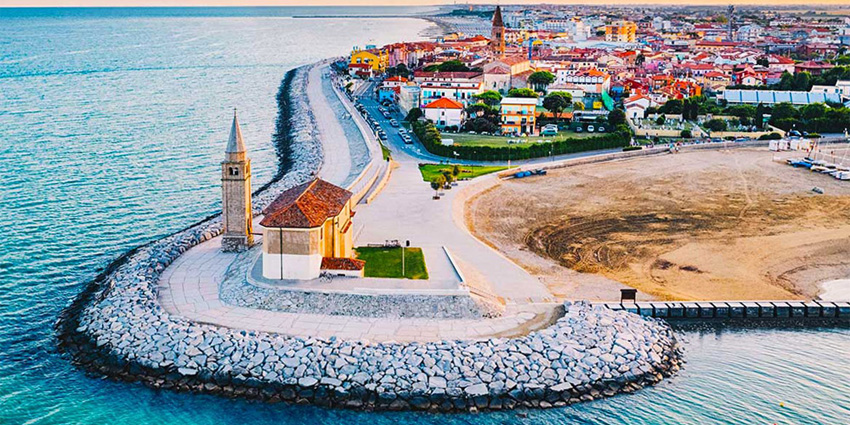
Caorle, the Little Burano on the Adriatic Sea
Nestled along the Venetian coast and overlooking the Adriatic Sea, Caorle is one of the most charming and authentic destinations in northeastern Italy.
Often referred to as the “Little Burano”, this seaside town stands out for its colorful historic center, reminiscent of the famous island in the Venetian lagoon.
Caorle offers much more than a typical beach resort: it’s a place where history, seafaring tradition, and unspoiled natural landscapes come together. It is one of the few seaside locations in the Veneto region that still preserves a genuine old town, full of picturesque corners and centuries of maritime heritage.
The Historic Center: Venetian Soul and Fishermen’s Traditions
Strolling through Caorle’s historic center feels like stepping into a timeless fishing village. The narrow alleys, small squares, and brightly colored fishermen’s houses create a welcoming and enchanting atmosphere. Every street tells the story of a community rooted in the sea and its ancient customs.
At the heart of the town stands the Cathedral of St. Stephen, built in the 11th century in Romanesque-Ravennate style. Just in front of it, the iconic cylindrical bell tower with its conical base rises 48 meters high and has served as both a landmark and a lighthouse for centuries. It is now one of the most recognizable symbols of Caorle.
A short walk away is the Church of the Madonna dell’Angelo, perched on a small promontory overlooking the sea. Built in 1703, this small chapel holds great sentimental value for the locals and houses a statue of the Virgin Mary, said to have been found floating in the sea by fishermen.
The Seafront and the Sculpted Cliffs
One of Caorle’s most distinctive features is its seafront promenade, which runs along the rocky coastline leading to the Church of the Madonna dell’Angelo. What makes this walk unique is the sculpted cliff, an ongoing art project that began in the 1990s. Each summer, artists from around the world are invited to carve the large boulders, turning them into an open-air gallery. The result is a permanent exhibition where nature meets creativity.
The promenade is also a popular spot for quiet strolls and relaxation. With the sound of the waves and the scent of the sea air, it offers a deeply peaceful and contemplative experience.
The Lagoon and the Walk of the “Casoni”
Just outside the main town lies the Caorle Lagoon, a landscape rich in biodiversity and natural beauty. One of the most evocative experiences is the Walk of the Casoni, a route that leads through the wetlands to discover traditional wooden huts once used by local fishermen.
These “casoni”, made from wood and marsh reeds, are a living testament to the region’s fishing culture. Today, many of them have been preserved or faithfully reconstructed, offering insight into the simple and sustainable lifestyle of the past.
The area is especially magical at sunrise or sunset, when the lagoon reflects the changing colors of the sky—from soft pinks to deep golds—creating a truly unforgettable landscape.
Vallevecchia Nature Reserve
Among the most important protected natural areas near Caorle is the Vallevecchia Nature Reserve, located between Caorle and Bibione and easily accessible by bike. Vallevecchia is one of the last remaining stretches of untouched Adriatic coastline, with sand dunes, pine forests, and coastal wetlands that offer a rare example of original coastal habitat.
The reserve is a vital area for environmental research and biodiversity conservation. It is especially known among birdwatchers, with species such as herons, black-winged stilts, mallards, cormorants, and many others finding shelter in this peaceful ecosystem. Several marked trails invite visitors to explore the landscape on foot or by bicycle.
Vallevecchia is also a model of sustainable development, balancing conservation efforts with eco-friendly agriculture. Through environmental restoration projects and low-impact farming methods, it demonstrates how nature and human activity can coexist in harmony.




